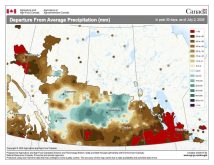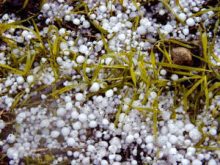We are finally beginning to see summer-like temperatures across our region and, along with the heat, a little more humidity. Despite some people getting a little grumpy about the cool weather pattern we’ve been in this last month or so, that cool weather prevented several regions transitioning from really dry to dangerously dry conditions.
That said, before we continue our look at thunderstorms and severe summer weather, I thought we should continue to investigate the current drought conditions. Maybe if we talk about it enough, we will finally get some much-needed rain. Just how dry has it been? It’s been so dry…
Read Also

Canadian canola prices hinge on rain forecast
Canola markets took a good hit during the week ending July 11, 2025, on the thought that the Canadian crop will yield well despite dry weather.
- The Winnipeg region has now seen 18 months in a row with below-average precipitation.
- This 18-month period saw a precipitation deficit of over 300 mm compared to average.
- We must go back to 2016 to find a year that had above-average precipitation across our region.
- 2010 was the last year all three regions saw well-above-average precipitation.
- The Brandon region would be even drier than the Winnipeg region, but it has seen several May-June periods with extreme rain events over the last 10 years.
I am sure there are more stats and stories, and I don’t want to make light of this situation, because if we see a prolonged period of summer heat move in with little or no rainfall, we could be in serious trouble. For now, we’ll focus more on what we want. On to thunderstorms and severe summer weather in the hopes that talking about it will make it happen — are you listening, Mother Nature?
We have gone into some detail on how thunderstorms develop and how they can go from your average summer-day thunderstorm to a severe thunderstorm. Thunderstorms can bring a wide variety of severe weather with them: heavy rains, hail, high winds, lightning and, on some occasions, tornadoes.
We’ll begin our look at these severe summer events with a look at what causes heavy rains. While we do not necessarily need thunderstorms to bring heavy rain events to our region, most of our really big rainfalls are associated with thunderstorms. As you probably already know, warm air can hold a heck of a lot more moisture than cold air. At -20 C the air can hold about one gram of water for every cubic metre. At 0 C that amount increases to around five grams; at 20 C it is around 17 grams, and it jumps all the way to 30 grams at 30 C. This would mean a storm system forming on a hot summer day can have up to six times more water to work with than if it were around the freezing mark.
I could go into all the potential energy that is stored in the water and is then released into the storm when it condenses into water droplets, but I will leave that for the next issue. For now, we just need to realize that these warm summer storms can have a lot of water to work with. If a thunderstorm was just dealing with the amount of water in the air within the thunderstorm itself, we would not actually see any huge rainfalls. If all the water in a column of air was condensed out (this is known as precipitable water), the most precipitation we could see is about 50 mm in our region. So how can we get storms that dump 100-250 mm? The answer: horizontal movement of air.
Training
If you never have, or have not done so in a while, I recommend going to earth.nullschool.net. I have talked about this website in the past; it is a good visual way of seeing the horizontal movement of air across the planet. If you watch the flow of air across our planet you will start to see how storm systems can tap into huge flows of air that can literally cover thousands of square kilometres. This means that as a storm is pulling out the moisture available for rainfall, new moisture is moving in to replace that moisture, allowing rainfall amounts to really ramp up. In thunderstorms, the movement of the storm and the short life cycle of the storm will put a limit on just how much rain can fall, but sometimes thunderstorms will stall over a region, allowing for some truly extreme rainfall events. Other times we can get something called thunderstorm training. This is when a series of thunderstorms form in the same general area and follow each other, one after another, bringing several rounds of heavy rainfall.
Just what is considered heavy rainfall across our region? According to Environment Canada, a short-duration summer rainfall warning will be issued if 50 mm of rain or more are expected within a one-hour period — usually caused by thunderstorms. Whereas a long-duration rainfall warning will be issued if 50 mm or more are expected to fall within a 24-hour period, or if 75 mm or more are expected to fall within 48 hours — usually the result of a slow-moving area of low pressure, though this could also be related to several rounds of heavy thunderstorms.
Next issue we will continue our look at severe summer weather by looking at high winds and hail.




















